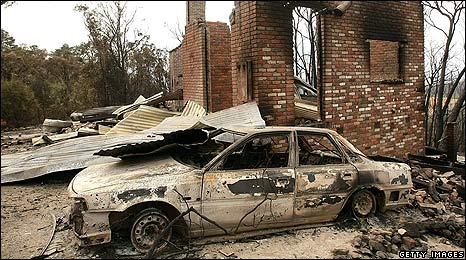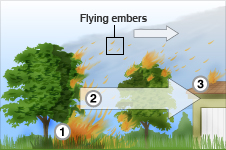|
The human cost of the current Australian bushfires is unprecedented. But with ample warning of the encroaching fires given to residents, why have so many perished?
Days before this weekend's infernos, the authorities urged people in the bushfire zones to evacuate early or stand their ground, but many victims appear to have been ill-prepared or fled at the wrong time.
It was the speed at which the fire fronts travelled that appears to have caught many out.
A prolonged drought combined with record-high temperatures turned the south-eastern state of Victoria into a powder keg.
Human error - or deliberate acts of arson - added to this volatile mix, sparking more than 100 fires on Saturday alone.
Australian bushfires can move with terrifying pace, partly because native Eucalypt forests throw out lots of embers, sparking new fires.
 |
HOW BUSH FIRES SPREAD
1 Fires start in hot dry windy weather
2 Embers blown ahead of fire front
3 Spot fires start where embers land
|
Bushfire experts say that people who thought they had plenty of time to get away suddenly found themselves trapped in the middle of a "fire storm".
Kevin Tolhurst is an Australian fire behaviour specialist who has tracked hundreds of bushfires.
He says many of the victims appear to have left their homes too late.
"They've waited to see the fire. If you see smoke or you're underneath the smoke plume then you ought to be concerned and if your plan is to evacuate, that's the time to do it."
The University of Melbourne expert says a fire's progress is not constant but can "pulse" - a movement which catches people out.
For example in a forest a fire moves at 5km/h on average and in grassland areas it can be about 10km/h. But at times the fire can cover 400m to 600m in a matter of seconds.
"A pulse can go as quick as the speed of the wind. People think they're a safe distance away but suddenly they find themselves surrounded by fire. The time to respond is very short," says Mr Tolhurst.
Facing a fire front
Those who choose not to evacuate their home must be prepared to defend their properties and be brave enough to stand their ground.
Before the fire front passes, this means clearing an area around the house of vegetation likely to burn, hosing down the property and stamping out embers - anything to prevent the house from igniting.
As the fire closes in, residents are advised to stay away from the windows where the heat radiation is most intense, and breathe through a cloth to protect their lungs.
"It takes several minutes at least before a house catches alight fully and provides refuge for some time," says Mr Tolhurst.
"Even if you're not successful in saving the house at least you have been saved in the time that the main fire has passed, then you can escape outside."
 |
AUSTRALIAN BUSH FIRES
16 February 1983: 75 dead, 2,300 homes destroyed in "Ash Wednesday" bushfires in Victoria and South Australia
8 January 1969: At least 22 dead, 230 homes lost in rural Victoria
7 February 1967: 62 dead, 1,300 homes destroyed in fires in Hobart, Tasmania
13 January 1939: 71 dead, 700 homes destroyed in "Black Friday" fires in Victoria
February - March 1922: 60 die in Gippsland, eastern Victoria
|
Those who have survived a fire front say the heat and the noise are overwhelming, leaving them with a sense of helplessness when confronted with such an enormous force.
The air is incredibly hot and full of gases combusting, making it difficult to breathe. The heat radiation is inescapable as the wall of flames moves continually forward.
Many of those who perished in the fires were trapped in their cars, according to Australian media reports.
The air inside the car heats up quickly because it is such a small space, says Mr Tolhurst. The only way to survive is to get down low and cover yourself with a blanket or cloth.
You can get out of the car within in a couple of minutes of the fire passing but experts say that Saturday's fires were so intense that many were unable to withstand the heat.
Educated and prepared
Bushfires are an inevitable and intrinsic element in the life cycle of Australia's forests. Their menace is one faced every year.
Climate change, weather and drought are altering the nature, ferocity and duration of bushfires.
So what lessons will be learned from recent tragic events?
Gary Morgan, the head of Australia's Bushfire Cooperative Research Centre, says that one of the main issues highlighted by the fires is that of increased development of rural areas.
He says: "Many communities need to re-think the notion of who lives in a bushfire zone and who needs to be educated and prepared."
|

~RS~q~RS~~RS~z~RS~03~RS~)







Bookmark with:
What are these?